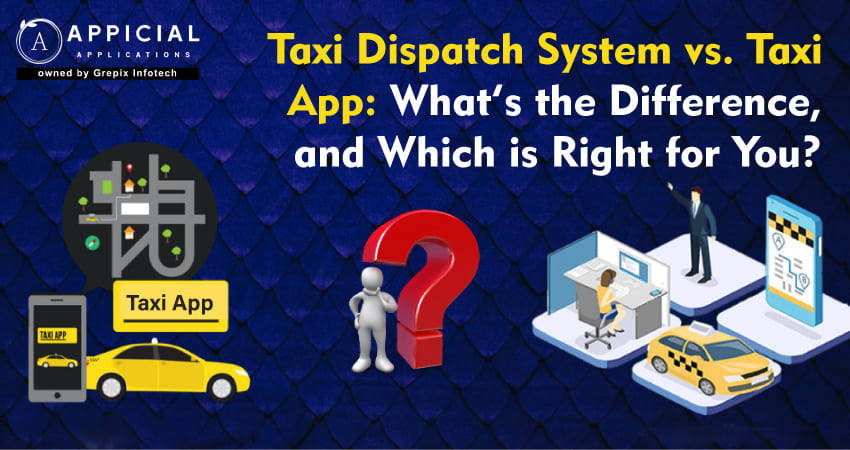
Taxi Dispatch System vs. Taxi App: What’s the Difference, and Which is Right for You?
The modern taxi and transportation industry has seen a surge in technology-driven solutions. Taxi dispatch systems and taxi apps are two prominent models that dominate the market, each with its unique advantages and operational structure. For those entering the taxi business, the choice between these two options is essential and has long-lasting impacts on operations, customer experience, and revenue.
This article will delve into the core differences between a traditional taxi dispatch system and a taxi app, discuss the pros and cons of each, and provide insights on choosing the right system for your business needs.
The taxi industry now offers two main tech-driven solutions: taxi dispatch systems and taxi apps. Each option brings unique advantages and operational styles, shaping a company's customer experience and revenue model. Taxi dispatch systems provide centralized management, ideal for companies valuing close oversight and traditional service. Meanwhile, taxi apps prioritize automation, flexibility, and a seamless user experience, catering to tech-savvy customers and businesses with growth goals. Appicial Applications bridges these options, providing hybrid solutions that combine the control of dispatch systems with the convenience of taxi apps. With Appicial's customizable approach, businesses can meet modern demands while aligning with their long-term vision.
Understanding the Basics
What is a Taxi Dispatch System?
A taxi dispatch system is a centralized solution to manage taxi bookings, allocate drivers to customers, and oversee fleet operations. This traditional model relies on dispatchers, who are responsible for receiving ride requests, assigning drivers, and managing fleet availability. Dispatch systems often use GPS technology to track vehicles, ensuring drivers are optimized and able to meet demand efficiently.
Key components of a taxi dispatch system include
- Dispatcher Console: The central hub where dispatchers receive and manage booking requests.
- Driver Application: An interface for drivers to receive assigned rides, navigate to destinations, and communicate with dispatchers.
- Tracking Software: A GPS-based tool to monitor vehicle location, providing insights on driver behavior, speed, and route efficiency.
Taxi dispatch systems have been the backbone of many traditional taxi services for decades, providing a reliable structure for fleet management and customer service.
What is a Taxi App?
A taxi app, on the other hand, is a digital solution designed for on-demand ride requests directly from a smartphone. Popularized by companies like Uber and Lyft, taxi apps offer a seamless experience for riders, allowing them to request rides, track vehicles in real time, and make payments within the app. This system eliminates the need for a central dispatcher, as rides are automatically matched with the nearest available driver using GPS technology and algorithms.
Core components of a taxi app include:
- Customer App: The interface where customers book rides, view estimated fares, track driver arrival, and rate the experience.
- Driver App: This app for drivers to receive ride requests, navigate to pickup and drop-off locations, and receive payments.
- Admin Panel: A management tool for operators to monitor trips, track driver activity, and access business insights.
Taxi apps are highly automated, prioritizing customer convenience and speed, which makes them an appealing choice in today’s digital age.
Key Features and Functionalities
1 Dispatch System Features
Taxi dispatch systems are designed to ensure structured management of a fleet and offer features for efficient ride allocation, driver tracking, and operational oversight. Common features include:
- Centralized Booking Control: Dispatch systems give fleet managers complete control over bookings, allowing them to manually assign rides to drivers based on proximity, availability, or other criteria.
- Real-Time GPS Tracking: Managers can monitor driver locations in real-time, ensuring safety, efficiency, and a faster response to customer requests.
- Automated Job Assignment: Advanced dispatch systems can automatically assign jobs based on location, time, and demand, reducing dispatcher workload.
- Multi-Channel Booking: Dispatch systems often allow bookings via multiple channels, including phone calls, website reservations, or third-party integrations.
- Driver Communication Tools: Direct communication channels between dispatchers and drivers, often mobile apps or in-car devices, help coordinate efficiently.
2 Taxi App Features
Taxi apps are built with customer experience in mind, offering features that make booking and using a taxi service easy and fast:
- Instant Ride Matching: The app matches customers with the nearest available driver automatically, cutting down wait times and reducing the need for manual intervention.
- Real-Time Tracking for Customers: Riders can view their driver’s location on a map, track estimated time of arrival, and stay informed of route changes.
- Cashless Payment Integration: Taxi apps offer in-app payment options, which add convenience and reduce reliance on cash. Customers can pay via card, mobile wallets, or other digital means.
- Rating and Feedback System: Customers can rate their drivers and provide feedback, helping maintain quality service standards.
- Push Notifications: Apps send real-time alerts about driver arrival, ride progress, and payment confirmation, keeping customers informed throughout the journey.
Also Read: How to Launch a Taxi App: From Idea to Execution in 6 Steps
Comparative Analysis: Taxi Dispatch System vs. Taxi App
1 Operational Differences
A traditional dispatch system relies heavily on the dispatcher’s role, serving as the middleman between customers and drivers. The dispatcher is responsible for assigning rides and ensuring fleet efficiency. This model works well for companies that prioritize operational control and direct oversight.
Conversely, a taxi app offers a more autonomous model, using automation to connect riders directly with drivers. The app relies on algorithms to match drivers with riders, eliminating the need for dispatchers. This system offers greater flexibility and scalability, ideal for companies looking to serve a large number of customers without extensive human resources.
2 Flexibility and Scalability
Taxi apps generally offer greater scalability. Adding drivers to a taxi app platform can be done with minimal setup costs, as drivers need only download the app, complete necessary checks, and start accepting rides. This is particularly beneficial for companies aiming to expand their geographic reach quickly.
Dispatch systems, however, are less flexible in scaling due to their reliance on centralized management and dedicated hardware. Expanding operations with a dispatch system often requires more investment in dispatch staff, software licenses, and infrastructure, which can be costly.
3 Cost Structure
The cost structure for a taxi dispatch system usually includes an upfront investment in software, equipment, and regular maintenance costs. These costs vary depending on the system’s complexity and the number of vehicles in the fleet. Over time, dispatch systems may be more economical for operators who don’t want ongoing commission fees but prefer a one-time setup with lower recurring costs.
Taxi apps, on the other hand, typically use a commission or subscription-based model, where the app provider takes a percentage of each fare or charges a monthly fee. This model is favorable for those seeking a low initial investment, but it can result in higher operational costs over time, especially as ride volumes increase.
4 Customer Experience
Taxi apps are generally more customer-focused, providing a smooth and user-friendly experience. Features like real-time tracking, in-app payments, and the rating system enhance customer satisfaction and loyalty. Additionally, the self-service nature of taxi apps means customers have more control over their ride experience, which appeals to today’s convenience-oriented users.
Dispatch systems may lack some of these customer-centric features, as they rely on dispatcher-customer interactions and often don’t offer GPS tracking or cashless payments. However, a dispatch system can appeal to a market that values personalized customer service and direct human interaction.
Pros and Cons of Taxi Dispatch System
1 Pros of a Taxi Dispatch System
- Greater Oversight: Centralized control allows for structured fleet management and close monitoring of driver behavior.
- Personalized Customer Service: Dispatchers provide a personal touch, which may appeal to customers who prefer direct interaction over automated service.
- Better Suited for Non-Digital Customers: Customers who make phone reservations or walk-ins can be accommodated by a dispatch system in areas with low smartphone penetration.
2 Cons of a Taxi Dispatch System
- High Initial Investment: Requires upfront spending on software, equipment, and potentially additional staff.
- Limited Scalability: Scaling operations with a dispatch system can be resource-intensive and costly.
- Less Automation: This relies on human dispatchers, making it less automated and efficient than app-based models.
Pros and Cons of Taxi App
1 Pros of a Taxi App
- Convenience for Customers: Customers enjoy a seamless experience with easy booking, tracking, and in-app payments.
- Lower Startup Costs: Commission or subscription models reduce the need for upfront investment, making it accessible for smaller operators.
- High Scalability: Taxi apps can quickly expand their driver base without significant infrastructure changes.
2 Cons of a Taxi App
- Reliance on Technology: Taxi apps require smartphone access and data connectivity, which may be barriers in certain markets.
- Higher Competition: The ride-hailing market is highly competitive, which can lead to price pressures and thin profit margins.
- Lower Operational Control: With no central dispatcher, ensuring driver compliance and service quality can be more challenging.
Choosing the Right Solution: Factors to Consider
1 Business Size and Goals
If you operate a small, local taxi business with a modest fleet, a traditional dispatch system may meet your needs without the complexity of an app. However, if you have ambitious growth plans and intend to serve a broad customer base, a taxi app’s scalability may be more appropriate.
2 Target Audience
Consider the demographics of your customer base. Younger, tech-savvy customers will likely prefer a taxi app with modern conveniences like cashless payments and real-time tracking. However, a traditional dispatch system may resonate more with an older customer base or regions with low smartphone usage.
3 Operational Control Needs
For companies that prioritize driver oversight and structured fleet management, a dispatch system provides the necessary control and monitoring tools. Taxi apps are ideal for companies that value automation and want to minimize operational complexity, even if it means sacrificing some control over day-to-day operations.
4 Budget and Profit Margins
Analyze your budget and financial goals carefully. Dispatch systems can have higher upfront costs but lower recurring fees. In contrast, taxi apps offer lower initial costs but may eat into profit margins through commissions and subscription fees.
Future Trends and Hybrid Solutions
The line between taxi dispatch systems and apps is beginning to blur as hybrid solutions emerge. These hybrid platforms combine traditional dispatch features with app-based functionalities, offering a centralized management approach alongside automated, customer-centric features. This approach allows companies to benefit from the control of a dispatch system while offering the convenience and tech-forward features that customers expect from a taxi app.
Hybrid models could represent the future of taxi service management, offering companies a balanced solution that provides operational oversight and customer convenience.
Conclusion
the choice between a traditional taxi dispatch system and a taxi app depends on your business's specific goals, budget, and target audience. A traditional dispatch system provides centralized management, higher operational control, and personalized customer service, making it ideal for companies prioritizing oversight and serving a less tech-savvy clientele. Taxi apps, on the other hand, offer automation, scalability, and enhanced customer experience, appealing to younger, tech-oriented users and businesses looking to expand quickly with minimal infrastructure costs.
structured control of a dispatch system alongside the convenience and customer engagement features of a taxi app. This flexibility positions Appicial as a valuable partner in adapting to the evolving needs of the transportation industry, enabling businesses to thrive by balancing control with customer convenience. Whether you aim for a traditional setup or a modern app-driven approach, Our technology can help align your operations with your long-term vision.
Looking out to start your own venture like Uber? Try out our HireMe Uber Clone, the easiest way to kick-start your taxi business.






